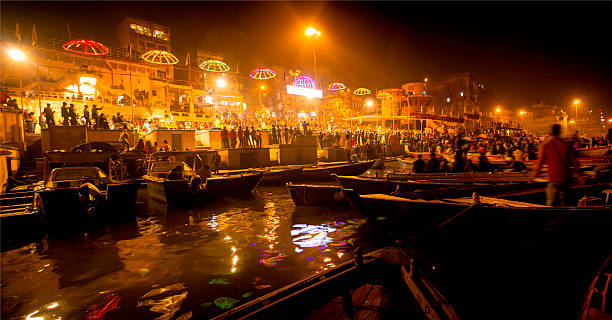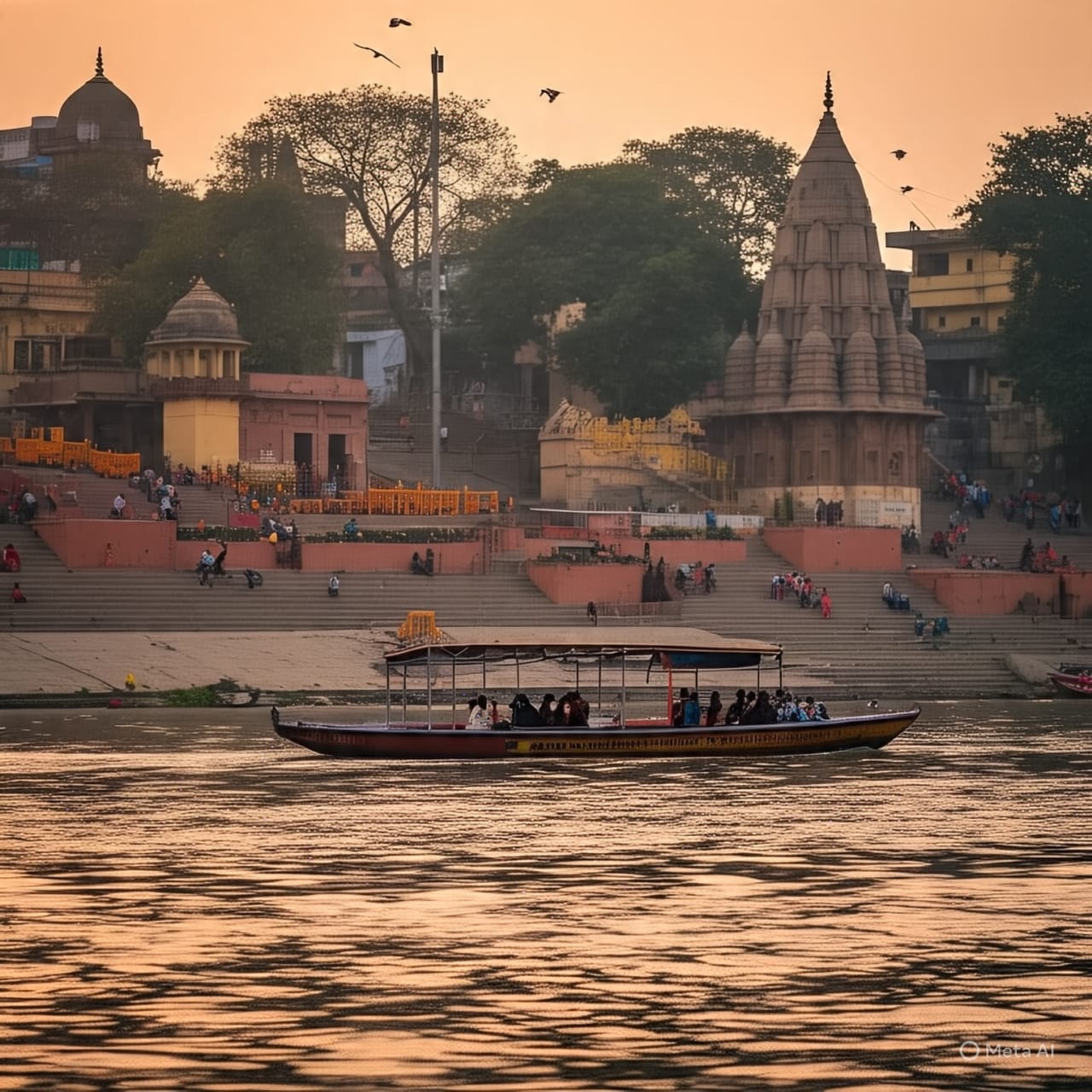Introduction
Varanasi’s Ancient Ghats
Experience the timeless spirituality and rich cultural heritage of Varanasi on a transformative journey. Explore ancient temples, ghats teeming with life, and sacred rituals that have shaped this city for millennia. Discover the captivating stories woven into the very fabric of Varanasi, a city that resonates with history and devotion.

Varanasi, a city steeped in history and spirituality, offers a captivating journey through time for those willing to explore its ancient ghats. A heritage walk along these sacred steps provides an unparalleled glimpse into the city’s rich cultural tapestry, revealing layers of history interwoven with daily life. Beginning at the northernmost ghats, one is immediately struck by the sheer scale and grandeur of these structures, each with its own unique story to tell. These aren’t merely steps leading to the Ganges; they are vibrant, living spaces, where rituals, commerce, and community life intertwine.
For instance, the ghats dedicated to cremation, such as Manikarnika and Harishchandra, offer a poignant, albeit sobering, perspective on the cycle of life and death. Witnessing the funeral pyres burning continuously along the riverbank is a powerful experience, a stark reminder of the transient nature of existence, a concept deeply ingrained in Varanasi’s spiritual fabric. However, this solemn spectacle is not detached from the everyday; the air is filled with the chanting of priests, the cries of mourners, and the rhythmic sounds of the wood being prepared for the next cremation. This juxtaposition of life and death, of the sacred and the mundane, is a defining characteristic of Varanasi.
Moving south along the river, the atmosphere shifts subtly. Ghats like Dasashwamedh and Scindia are bustling with activity, a far cry from the contemplative atmosphere of the cremation ghats. Here, the focus shifts from the spiritual to the social. These ghats are the heart of Varanasi’s daily life, where pilgrims bathe in the holy waters, sadhus meditate, and vendors hawk their wares. The air is thick with the scent of incense, the sounds of devotional chants, and the chatter of a thousand conversations. One can observe the intricate rituals performed by priests, the vibrant colours of the saris worn by women, and the serene expressions of those seeking solace in the river’s embrace.
Furthermore, a heritage walk allows for a deeper understanding of the architectural styles prevalent in Varanasi. The ghats themselves are a testament to centuries of construction and renovation, reflecting the changing tastes and influences of various rulers and dynasties. From the imposing stone structures to the more modest, intricately carved steps, each ghat reveals a unique architectural narrative. Observing the details – the intricate carvings, the weathered stone, the subtle variations in design – provides a tangible connection to the city’s past. Moreover, many ghats are adorned with temples and shrines, further enriching the architectural landscape and offering glimpses into the diverse religious beliefs that have shaped Varanasi over the centuries.
In conclusion, a heritage walk along Varanasi’s ancient ghats is more than just a sightseeing tour; it’s an immersive experience that allows one to connect with the city’s soul. It’s a journey through time, a tapestry woven from threads of spirituality, history, and daily life. By observing the rituals, the architecture, and the interactions of the people, one gains a profound appreciation for the enduring legacy of this ancient city, a place where the past, present, and future converge on the banks of the sacred Ganges. The experience leaves an indelible mark on the visitor, a lasting impression of a city that continues to captivate and inspire.
Beyond the Ghats: Exploring Varanasi’s Hidden Heritage Gems
Varanasi, a city steeped in ancient history and spiritual significance, is renowned for its ghats, the iconic steps leading down to the Ganges River. However, a truly enriching experience in this sacred city extends far beyond the bustling riverfront. Indeed, venturing beyond the ghats reveals a wealth of hidden heritage gems, offering a deeper understanding of Varanasi’s multifaceted cultural tapestry. To fully appreciate Varanasi, one must explore its less-visited corners, uncovering the layers of history embedded within its narrow lanes and ancient structures.
For instance, a visit to the Bharat Kala Bhavan museum is essential. This renowned museum houses an impressive collection of Indian art, spanning various periods and styles. From exquisite Mughal miniatures to breathtaking sculptures and intricate textiles, the museum provides a captivating journey through India’s artistic heritage. Furthermore, the museum’s serene atmosphere offers a welcome respite from the vibrant energy of the city, allowing for quiet contemplation of the masterpieces on display. Moving from the visual arts to the architectural wonders of Varanasi, one can discover numerous hidden temples and shrines tucked away in the labyrinthine alleys.
These often-overlooked sites offer a glimpse into the city’s rich religious past. Many are adorned with intricate carvings and boast unique architectural styles, reflecting the diverse influences that have shaped Varanasi over the centuries. Moreover, exploring these smaller temples provides an opportunity to interact with local communities and gain a more intimate understanding of their daily lives and religious practices. This personal interaction adds a layer of authenticity to the experience, moving beyond the tourist gaze to engage with the living heart of Varanasi.
Beyond the religious sites, Varanasi also boasts a fascinating history of craftsmanship. The city has long been a center for traditional arts and crafts, with skilled artisans continuing to practice age-old techniques. Consequently, a visit to a local workshop, perhaps specializing in silk weaving or pottery, offers a unique opportunity to witness these skills firsthand and even purchase handcrafted souvenirs. This interaction with the artisans provides a deeper appreciation for the dedication and artistry involved in creating these beautiful objects, connecting the visitor to the city’s vibrant cultural heritage.
Finally, to truly immerse oneself in the essence of Varanasi, a stroll through the city’s less-traveled lanes is highly recommended. These narrow pathways, often lined with ancient houses and bustling markets, reveal a different side of Varanasi, one less touched by tourism. Here, one can observe the daily routines of the locals, experience the vibrant energy of the markets, and discover hidden courtyards and unexpected architectural details. In essence, these hidden corners offer a glimpse into the authentic heart of Varanasi, a city that continues to evolve while preserving its rich and complex heritage. Therefore, while the ghats are undoubtedly a highlight of any visit, exploring Varanasi’s hidden heritage gems provides a far more complete and rewarding experience, revealing the true depth and beauty of this ancient city.
Varanasi’s Spiritual Heritage: Temples, Traditions, and Transformations
Varanasi, a city steeped in ancient history and spiritual significance, offers a profound journey into the heart of India’s religious landscape. A heritage tour of Varanasi unveils not only its magnificent temples but also the intricate tapestry of traditions and the ongoing transformations shaping its identity. The city’s spiritual heritage is palpable, woven into the very fabric of daily life, from the rhythmic chanting of mantras to the vibrant rituals performed along the sacred Ganges.
One cannot begin to explore Varanasi’s spiritual heritage without acknowledging the Ganges River, the lifeblood of the city. For centuries, the river has been revered as a sacred entity, its waters believed to possess purifying powers. The ghats, the steps leading down to the river, are the focal points of daily life and religious observance. Here, pilgrims bathe, perform rituals, and offer prayers, creating a mesmerizing spectacle of faith and devotion. Furthermore, the cremation ghats, where the final rites are performed, represent a unique aspect of Varanasi’s spiritual landscape, a poignant reminder of the cycle of life and death.
Beyond the river, the city boasts a wealth of temples, each with its own unique history and architectural style. The Kashi Vishwanath Temple, dedicated to Lord Shiva, is perhaps the most renowned, a dazzling structure adorned with intricate carvings and shimmering gold. Its significance extends beyond its architectural beauty; it stands as a symbol of unwavering faith and a testament to the enduring power of religious devotion. Similarly, the Durga Temple, dedicated to the goddess Durga, showcases a different architectural style, reflecting the diverse influences that have shaped Varanasi’s religious landscape over the centuries. These temples, however, are not merely structures of stone and mortar; they are living spaces, pulsating with the energy of prayer and devotion.
However, Varanasi’s spiritual heritage is not confined to its physical structures. It is also embodied in the traditions and practices that have been passed down through generations. The daily aarti ceremonies, performed at sunset on the ghats, are a breathtaking display of devotion, with priests chanting hymns and offering prayers amidst the flickering flames of lamps. These ceremonies, along with the numerous smaller rituals performed throughout the day, create a vibrant and immersive spiritual experience for both residents and visitors. Moreover, the city’s vibrant street life, filled with the sounds of chanting, the aroma of incense, and the sight of saffron-robed sadhus, contributes to the overall spiritual atmosphere.
In recent years, Varanasi has undergone significant transformations, facing challenges related to urbanization, tourism, and environmental concerns. Nevertheless, the city’s spiritual heart remains strong. Efforts are underway to preserve its heritage while addressing the challenges of modern development. The delicate balance between preserving tradition and adapting to change is a constant negotiation, a testament to the city’s resilience and its enduring commitment to its spiritual identity. Ultimately, a heritage tour of Varanasi is not just a journey through time and space; it is a journey into the heart of a living, breathing spiritual tradition, one that continues to evolve while retaining its profound essence. The city’s enduring spirit, its unwavering faith, and its commitment to its rich heritage ensure that Varanasi will continue to captivate and inspire for generations to come.
Q&A
Q1: What are some key historical sites included in a typical Varanasi heritage tour?
Kashi Vishwanath Temple, Sarnath (Deer Park), Ramnagar Fort, Manikarnika Ghat, Dasashwamedh Ghat, Bharat Mata Temple.
Q2: What is the best time of year to take a Varanasi heritage tour?
October to March (winter months), offering pleasant weather.
Q3: What kind of experiences are typically offered beyond sightseeing on a Varanasi heritage tour?
Ganga Aarti ceremony witnessing, boat rides on the Ganges, interaction with local artisans and weavers, exploring local markets and food stalls.
Conclusion
A Varanasi heritage tour offers an unforgettable journey through time, revealing the city’s rich spiritual, cultural, and historical tapestry. From the ancient ghats to the bustling markets and sacred temples, the experience leaves a lasting impression, showcasing the enduring legacy of this timeless city. While demanding, the immersion in Varanasi’s vibrant life and profound traditions provides a unique and deeply rewarding travel experience.





